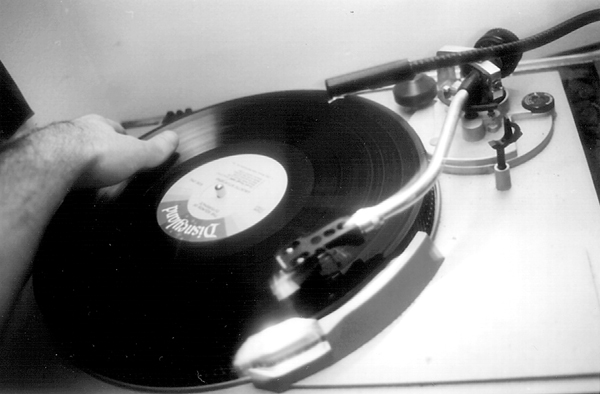How to Make the Most of the Format’s Limitations
Humor me while I put on my Captain Obvious cape, won’t you? Vinyl’s back, baby! Or…insert some other generic phrase from Squaresville, where mainstream news outlets are just now catching on to the fact that people still listen to and collect records. For most DIY musicians, this is simply not news. So let’s assume you’ve already started thinking about your next record. Sound good?
FULL-LENGTH ALBUMS
If you’re considering a vinyl release for your upcoming LP, there a number of considerations to keep mind when it comes to your album’s track listing and sequencing. On a standard CD, you can pack up to 80 minutes of audio, with no regard for how track placement or length with affect the sound quality of your recording.
When it comes to mastering vinyl, things get a little bit trickier. Due to the angle at which your tonearm and stylus track across the record, there’s the chance for certain distortions to creep into the audio playback, wh
en there were none present in the master recordings. The most egregious of these is called “inner groove distortion.” This occurs when the needle reaches, you guessed it, the inner grooves of the record at the end of a side. Because of the tangential nature of the tracking angle, if any part of the cartridge’s setup is misaligned during playback (azimuth, tracking angle, tracking force, anti-skate, overhang, etc), extreme distortion and (most noticeably) sibilance, or harsh “S” sounds, become all-too apparent.
Vinyl also has some physical limitations that have to be considered when you sequence your album. For starters, you’ll only be able to fit between 18-20 minutes comfortably on each side. This means you’ll have to carefully time each song and “rough out” a basic Side A and Side B configuration. The format can accommodate slightly more music per side, but you risk even more distortion as grooves will be cut closer together, further limiting frequency response in the inner portion of the record.
After you decide which tracks are going to be placed on each side, it’s recommended that you put “hotter” songs, or tracks with more frequency information, at the beginning of each side. That way, mellower songs, or tracks with less frequency information, can be placed at the end of the side. With less room for musical information, packing the end of each side with blistering tracks will all but ensure you end up with noticeable inner groove distortion, even on good playback systems. For an example of a well-sequenced album, look no further than The Replacements’ Tim. Side A kicks off with the rocking “Hold My Life” and ends with the more subdued “Swingin’ Party.” Side B opens with glorious slop-rock of “Bastards of Young” and closes with the acoustic “Here Comes a Regular.”
So far, we’ve been assuming that you’re cutting your record at the standard 33 1/3 RPM on a 12-inch disc. While that’s the accepted format for most LPs, there has been a rise in audiophile pressings done at 45 RPM. This speed actually allows for more audio resolution, if you will, per minute than 33 1/3 records, which is why recent high-end pressings have gone this route. If you plan on doing a 45 release for an LP, keep in mind that it will require twice as many sides (4) than a standard LP, and you will therefore need to typically pay the costs associated with a double album. For a 45 release of your full-length 12-inch, you should plan on no more than 10-12 minutes per side, maximum. This will ensure the most optimal sound quality. Again, you’ll still want to pay attention to track sequencing, as you’ll follow a similar pattern of placing “hotter” tracks at the opening of each side, and mellower tracks towards the inner grooves.
For metal bands, or artists with fewer mellow options, consider reducing the runtime of each side to compensate for potential inner groove distortion. For 33 1/3 12-inch records, stick to fewer than 15 minutes per side, if possible. And for 45 RPM 12-inces, about 8 minutes per side of brutal metal will suffice.
EPs and SINGLES
The sequencing of singles and short EPs is typically a little less involved. Since a 7-inch 45RPM is the standard for singles, for all intents and purposes there is no real inner groove to worry about. Track length is still an issue, however, as you’ll likely only be able to fit about 4:30 per side – just enough for a typical single. If you really want to squeeze an EP full of music on a 7-inch record, then you might want to try cutting at 33 1/3 RPM. This will give you about 6:15 per side, or about 12:30 total – not bad for a short EP. Just be sure to clearly mark on the record that it should be played back at 33 1/3, or else you’re going to have some very confused listeners.
RESOURCES
If this all sounds confusing, it means that I’ve done an incredibly poor job of writing. Scratch that, it means there are other resources available that will help you learn more about the physical limitations of cutting vinyl. We recommend United Record Pressing in Nashville for all of your vinyl needs. Not only will they be able to help answer any questions you might have, they also have tons of packaging and coloring options available.
For more info, visit the following sites:

